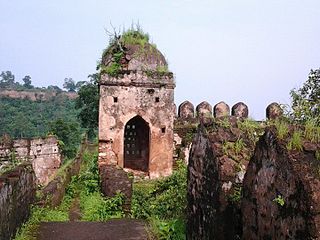
Palamu district is one of the twenty-four districts of Jharkhand state, India. It was formed in 1892. The administrative headquarter of the district is Medininagar, situated on the Koel River.
Ramgarh Raj was the major Zamindari estate in the era of the British Raj in the former Indian province of Bihar. Territories which comprised the Ramgarh Raj presently constitute districts of Ramgarh, Hazaribagh, Chatra, Giridih, Koderma, and Bokaro with 3672 villages. The entire area is rich in minerals like coal and mica and falls under the Indian State of Jharkhand. The First King was Maharaja Baghdeo Singh and the last ruling king was Maharaja Kamakhya Narain Singh of this estate, until the estate was merged to the Republic of India. The revenue of the estate was about 3600000.
The region have been inhabited since the Stone Age. Copper tools from the Chalcolithic period have been discovered. This area entered the Iron Age during the mid-2nd millennium BCE.

The Palamu fort are two ruined forts located 3 k.m from Betla National Park, Latehar district on the bank of Auranga River, in the Indian state of Jharkhand. The old fort in the plains, which existed even before the Chero dynasty, was built by the King of Raksel dynasty. The original fort in the plains and the other on an adjoining hill are attributed to the kings of the Chero dynasty. The fort in the plains had defences on three sides and three main gates. The New fort was constructed by Raja Medini Ray. East India company used this fort to prison Narayan Peshwa of Tiroha and Raja Radhkrishna alis Subedar Aftab Singh mutiniers of 1857.
Ranchi district is one among the twenty-four districts of the state of Jharkhand in Eastern India. This region was under the control of the Magadha Empire, then it was a part of the Mauryan Empire under Ashoka and later a part of the Gupta Empire. After the fall of the Gupta Empire a legendary king named Phanimukut established the Nagvanshi dynasty and controlled the Chota Nagpur plateau region for several centuries thereafter.

The Nagvanshis of Chotanagpur, was an ancient Indian dynasty which ruled the parts of Chota Nagpur plateau region during much of ancient, medieval and modern period. Phani Mukut Rai is considered the first king of dynasty claim to be son of Pundrika Naga a mythical Naga. Lal Chintamani Sharan Nath Shahdeo (1931–2014) was last ruling king of the dynasty, until the estate was merged to the Republic of India.
Nagpuria people or Sadan, are an Indo-Aryan speaking ethnolinguistic group who are the traditional speaker of Nagpuri language and native of western Chota Nagpur Plateau region of Indian state Jharkhand, Bihar, Chhattisgarh and Odisha.
Sadan are the native Indo-Aryan-speaking ethnolinguistic groups of Chota Nagpur Plateau consist of Indian state of Jharkhand and neighbouring states who speak Nagpuri, Khortha, Panchpargania and Kurmali language as their native language.

The Chero dynasty or Chyavana dynasty was a polity that ruled the northern regions of the Indian subcontinent, corresponding to the present-day Indian states of Bihar, Uttar Pradesh, and Jharkhand, after the fall of the Pala Empire; their rule lasted from the 12th century CE to the 19th century CE.

Raghunath Shah was a Nagvanshi king in the 17th century. He succeeded his father Ram Shah in 1663. His capital was at Navratangarh. He built several temples during his reign.
Pratap Karn (c.1451-c.1469) was Nagvanshi king in 15th century.
Dalel Singh was the king of Karnpura during the 17th century. He shifted his capital from Badam in Barkagaon, which is now in Hazaribagh district, to Ramgarh in 1670 and family has used Ramgarh in official and other work after changing their capitals to other place.
Ram Shah was Nagvanshi king in 17th century. He succeed his brother Durjan Shah and ruled from 1640 to 1663 CE. Earlier their capital was at Khukhragarh, but later they shifted to Navratangarh. He was brother of king Durjan Shah.
Yadunath Shah was a Nagvanshi king in the 18th century. His capital was at Navratangarh. He succeeded Raghunath Shah and ruled from 1790 to 1724 CE. He shifted his capital from Navratangarh to Palkot.
Dripnath Shah was a Nagvanshi king in the 18th century. His capital was at Palkot. He succeeded Maninath Shah and ruled from 1762 to 1790 CE. He became a vassal of the East India Company in 1771. He submitted list of Nagvanshi kings to Governor general of India in 1787.
Baghdeo Singh was founder of Ramgarh Raj in North Chotanagpur. He was king of Khayaragarh. He was made Fauzdar of Karra under the Nagvanshi. He suppressed rebellion in Tamar for Nagvanshi ruler. Nagvanshi send him to extract taxes from Karpurdeo the king of Karnpura. Baghdeo killed Karpurdeo and he declared himself as King of that region.
Nagpuri literature refers to literature in the Nagpuri language, the language of Jharkhand, Chhattisgarh and Odisha. The earliest literature started in the nagpuri language when the Nagvanshi king and king of Ramgarh Raj started writing poetry in the 17th century. Since then, various literature has been written. Although in the present century, Nagpuri was never considered worthy of literary development, a small but dedicated writers have engaged in writing short stories, plays and poetry.
Govind Nath Shah was a Nagvanshi king in the 19th century. His capital was at Palkot. He succeeded Deo Nath Shah and ruled from 1806 to 1822 CE.
Edward Tuite Dalton CSI was a British soldier and anthropologist. He was posted in Assam, then became commissioner of Chota Nagpur Division. He was posted in Chotanagpur for two decades. Later he became major general of Bengal Lancer. He commanded both European and native people during the sepoy mutiny of 1857. Dalton, along with justice Campbell, Herbert Hope Risley, John-Baptist Hoffmann and P.O.Bidding initiated ethnographic studies in Chotanagpur. His work Descriptive Ethnology of Bengal formed a part of the Census in British India in 1872.




